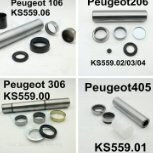-
Welcome to Auto Parts Forum
Whether you are a veteran automotive parts guru or just someone looking for some quick auto parts advice, register today and start a new topic in our forum. Registration is free and you can even sign up with social network platforms such as Facebook, X, and LinkedIn.
-
Similar Topics
-
By jeff C
I've been looking everywhere for a replacement driveshaft for my automatic 2006 saab92x and I can't find one. Is it even replaceable?
-
By austinbearing
Hello, everyone.We are an auto bearing manufacturer from China.
We produce Peugeot, Renault, Fiat and some other aut bearings.
Contact me if you're interested.
WhatsApp: +8613775640157
E-mail: [email protected]
-
By Dorman Products
Mechanic trivia: Do you know which vehicle has the longer wiper blade on the passenger side?
-
By Counterman
link hidden, please login to view announced the release of 116 new part numbers including starters, alternators, wiper motors, sensors, and transfer case motors. Coverage across these product lines includes the 2023 Toyota Tacoma 3.5L (Alternator), 2023 Nissan Kicks 1.6L (Starter), and 2023 Nissan Titan 5.6L (Wiper Motor), all of which are currently in stock and ready for immediate shipment, the company said.
“We are thrilled to introduce these new part numbers to our customers. Our dedication to innovation and quality ensures that we continue to lead the market in providing reliable parts. This release includes several first-to-market additions, demonstrating our commitment to delivering full-coverage solutions that meet the diverse needs of our customers. By consistently enhancing our product offerings, we reaffirm our position as a leader in the automotive industry” said Ron Bernstein, president of WAI North America.
link hidden, please login to viewsaid it offers full line offerings in alternators, starters, and test equipment. The company added that its product categories also include wiper motors, window regulators and motors, and an engine management program, including ignition distributors, ignition modules and coils, manifold air pressure (MAP) sensors, and mass air flow (MAF) sensors. The post
link hidden, please login to view appeared first on link hidden, please login to view.
link hidden, please login to view
-





Recommended Posts
Join the conversation
You can post now and register later. If you have an account, sign in now to post with your account.
Note: Your post will require moderator approval before it will be visible.